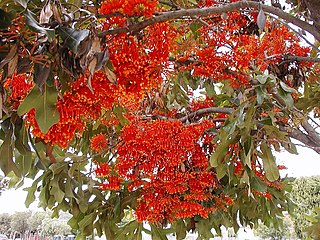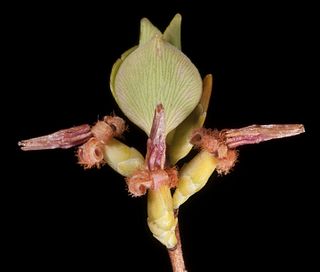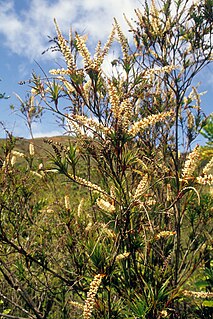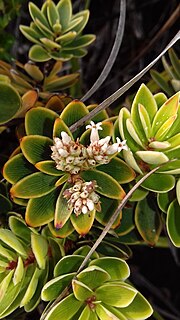
Knightia is a small genus of the family Proteaceae endemic to New Zealand, named in honor of Thomas Andrew Knight. One extant species, K. excelsa (rewarewa) is found in New Zealand. Two further Knightia species are found in New Caledonia, although they were placed in the genus Eucarpha by Lawrie Johnson and Barbara Briggs in their influential 1975 monograph "On the Proteaceae: the evolution and classification of a southern family", a placement supported in a 2006 classification of the Proteaceae. A fossil species from upper Miocene deposits in Kaikorai has been described as Knightia oblonga. Knightia has been placed in the tribe Roupaleae of the subfamily Grevilleoideae.

Tristaniopsis is a group of shrub and tree in the myrtle family Myrtaceae described as a genus in 1863. They have a wide distribution in Southeast Asia, New Guinea, New Caledonia and Australia.

The Joinvilleaceae are a family of flowering plants with a single genus including four species. The APG II system, of 2003 assigns it to the order Poales in the clade commelinids in the monocots. The family consists of one genus with four currently accepted species, distributed from the Malay Peninsula to the Caroline Islands and high islands in the Pacific Ocean. It is evolutionarily significant as a relictual group closely related to grasses. They closely resemble large grass plants, in both general appearance and microanatomy, but possess fleshy fruits.

Stenocarpus is a genus of about 22 species of flowering plants in the family Proteaceae. They are trees or shrubs with variably-shaped leaves, zygomorphic, bisexual flowers, the floral tube opening on the lower side before separating into four parts, followed by fruit that is usually a narrow oblong or cylindrical follicle.

Araucaria muelleri is a species of conifer in the family Araucariaceae. It is a medium size tree, 10–25 meters in height, with larger leaves than most other New Caledonian Araucarias. It is found only in New Caledonia, in several sites in the far south of Grande Terre, the main island.

Basselinia is a genus of flowering plant in the family Arecaceae. The entire genus is endemic to the Island of New Caledonia in the Pacific. In some molecular phylogenetic analyses, Hedyscepe from Lord Howe Island is nested in Basselinia.

Cyphophoenix is a genus of flowering plant in the family Arecaceae. It contains 4 known species, all endemic to New Caledonia. The relationships between Cyphophoenix and some other genera of the tribe Basseliniinae including Physokentia and the New Caledonia endemic Burretiokentia are not clear.

Beauprea is a genus of flowering plants in the family Proteaceae. Its 13 extant species are endemic to New Caledonia, though closely related forms have been found in the fossil records of Australia and New Zealand. Its closest extant relatives are the African Protea and Faurea.

Kermadecia is a genus of flowering plants in the family Proteaceae. The genus comprises five species, all endemic to New Caledonia. Its closest relatives are Sleumerodendron and Turrillia, of which the species have once been placed in Kermadecia.

Xanthostemon is a genus of trees and shrubs, constituting part of the myrtle plant family Myrtaceae. This genus was first described in 1857 by German–Australian botanist Ferdinand von Mueller. According to different official sources between 46 and 51 species are known to science. They grow naturally in New Caledonia, Australia, the Solomon Islands and Malesia, including the Philippines, New Guinea and Indonesia. The genera Pleurocalyptus and Purpureostemon from New Caledonia are morphologically close to Xanthostemon.

Cunonia is a genus of shrubs and trees in the family Cunoniaceae. The genus has a disjunct distribution, with 24 species endemic to New Caledonia in the Pacific, and one species in Southern Africa. Leaves are opposite, simple or pinnate with a margin entire to serrate. Interpetiolar stipules are often conspicuous and generally enclose buds to form a spoon-like shape. Flowers are bisexual, white, red, or green, arranged in racemes. The fruit is a capsule opening first around the base then vertically, seeds are winged.

Styphelia is a genus of shrubs in the family Ericaceae, native from Indo-China through the Pacific to Australia. Most have minute or small leaves with a sharp tip, single, tube-shaped flowers arranged in leaf axils and with the ends of the petals rolled back with hairs in the inside of the tube.

Melaleuca pancheri is a shrub or small tree in the myrtle family, Myrtaceae and is endemic to the south of Grande Terre, the main island of New Caledonia. It is one of only a few members of its genus to occur outside Australia and was formerly known as Callistemon pancheri Brongn. & Gris.
Eucarpha is a genus of flowering plant of the family Proteaceae, endemic to New Caledonia. Two species are recognised. Up to 1975, these were classified within the genus Knightia until Lawrence Johnson and Barbara G. Briggs recognised their distinctness, particularly their prominent bracts, in their 1975 monograph "On the Proteaceae: the evolution and classification of a southern family". Nomenclatural combinations for these two species in the genus Eucarpha were published in 2022. Other sources, including Plants of the World Online as of April 2022, treat Eucarpha as a synonym of Knightia.
Dubouzetia is a genus of about eleven species known to science, growing from shrubs up to large trees, in Papuasia and Australasia and constituting part of the plant family Elaeocarpaceae.

Coleanthera is a plant genus in the family Ericaceae. The genus is endemic to Western Australia, and is currently accepted by Plants of the World online, and the Council of Heads of Australasian Herbaria, but not by the Western Australian Herbarium, where it has been subsumed into the genus, Styphelia, for the phylogenetic reasons given by Darren M. Crayn, Michael Hislop and Caroline Puente-Lelièvre.

Dracophyllum ramosum is a species of shrub or small tree in the family Ericaceae and is endemic to New Caledonia. It was first described by Adolphe-Théodore Brongniart and Jean Antoine Arthur Gris in 1864 and gets the specific epithet ramosum for the fact that many of its branches grow from the same place. It inhabits the summits and slopes of mountains, alongside streams, and on plateaux; it reaches a height of 0.5–5 m.

Cyathopsis albicans is a species of plant in the family Ericaceae, endemic to New Caledonia. It was first described as Leucopogon albicans in 1864 by Adolphe-Théodore Brongniart and Jean Antoine Arthur Gris, and transferred to Cyathopsis in 2005 by Christopher John Quinn.
Eucarpha deplanchei is a species of flowering plant in the family Proteaceae, native to New Caledonia. It was first described in 1865 as Knightia deplanchei, the name used by Plants of the World Online as of April 2022.

Epacridoideae is a subfamily of the family Ericaceae. The name StyphelioideaeSweet is also used. The subfamily contains around 35 genera and 545 species. Many species are found in Australasia, others occurring northwards through the Pacific to Southeast Asia, with a small number in South America.

















